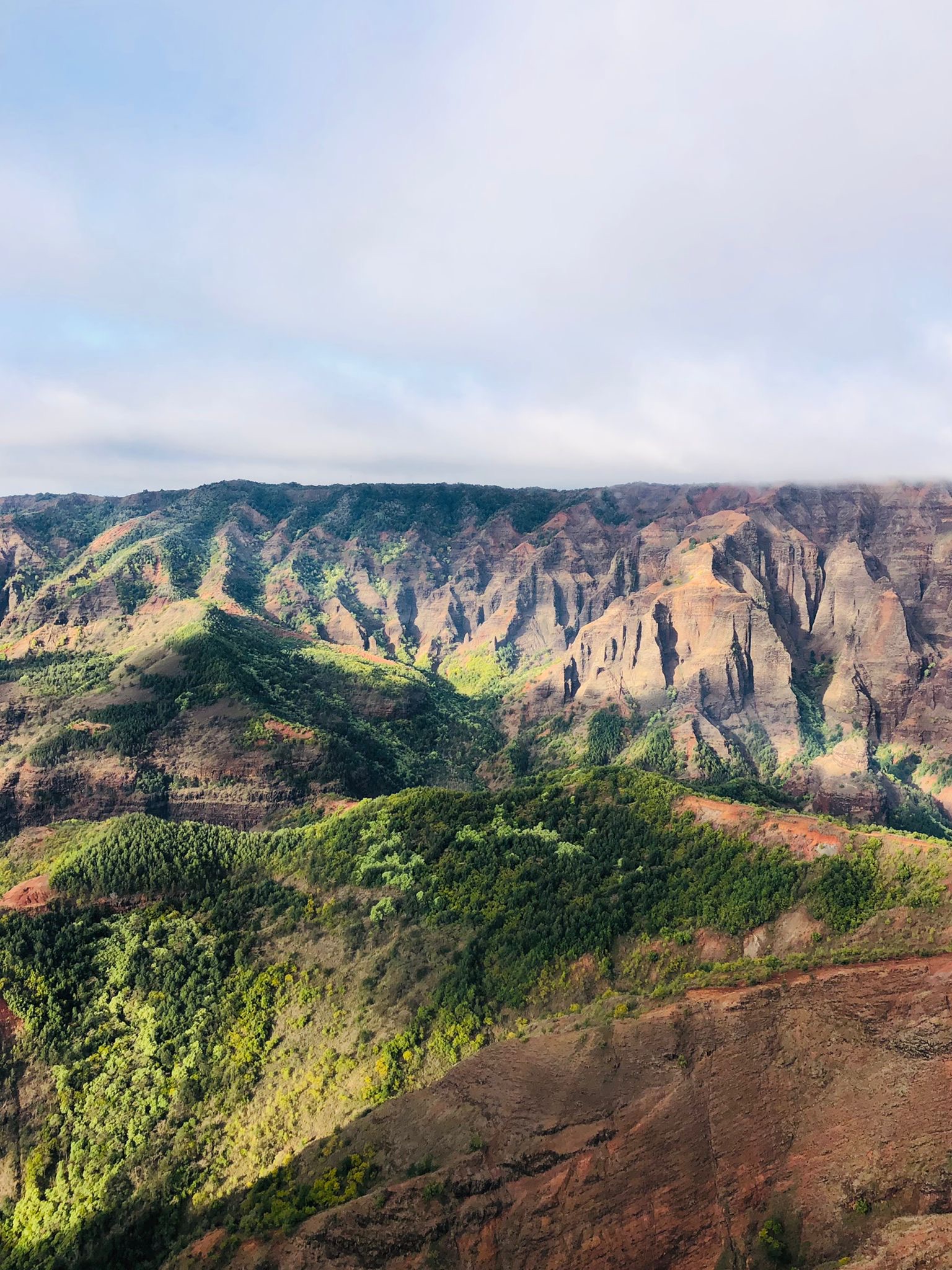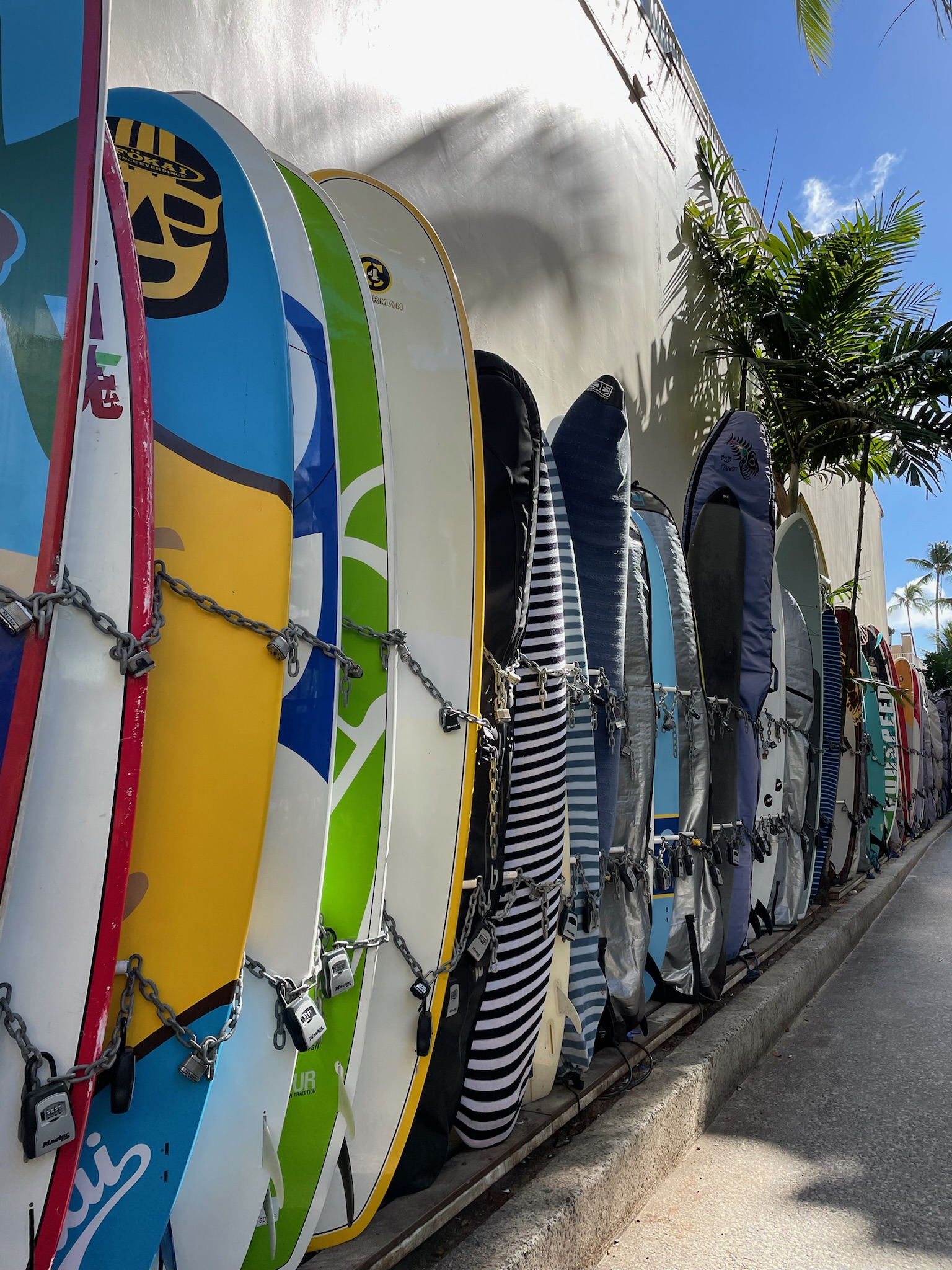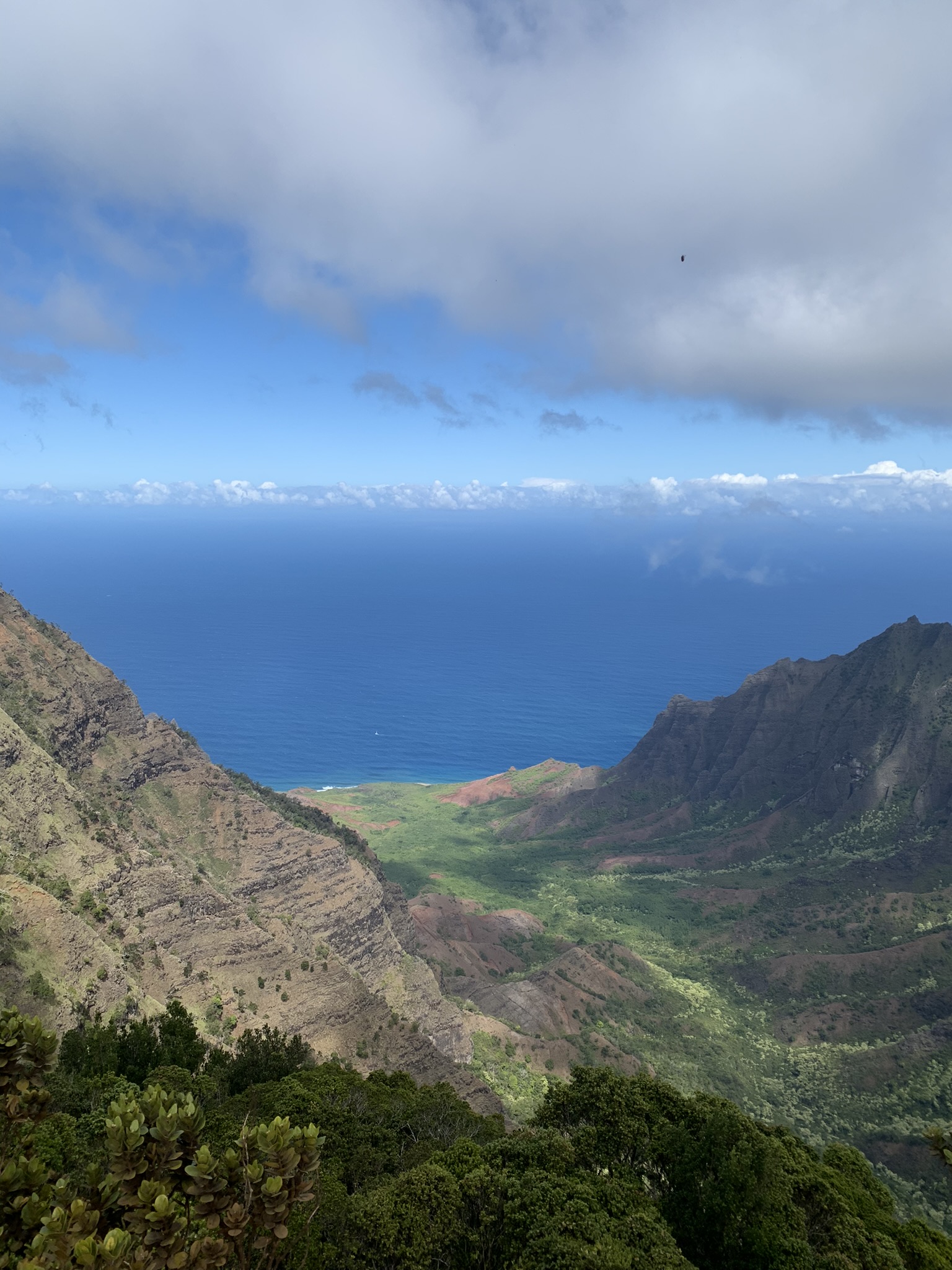Hawaï
Traveling to Hawaï
What to do?
Culture?
When to go?
Practical guide?
Travel to Hawaï
Why traveling to Hawaï
Food
Influences from a variety of cultures, including Polynesian, Asian, American, Portuguese and Japanese, are evident in the food served in Hawaii. (see more)
People
Hawaii's population is very diverse due to its geographical location and history. (see more)
Landscape
Hawaii's landscapes are extremely varied. There's something for everyone: beaches as beautiful as each other, hikes for all levels, and much more! (see more)
What to do?
The archipelago is made up of eight main islands: Ni'ihau, Kawa'i, O'ahu, Moloka'i, Lana'i, Kaho'olawe, Maui and Hawaii (called Big Island to avoid confusion with the name of the state).
1. O’ahu
It's Hawaii's most populous island and also home to the capital Honolulu. The island is home to the famous Waikiki Beach, a popular spot for beginners.
The Pearl Harbor historic site is a must-see on the island of O'ahu. The USS Arizona Memorial is accessible by shuttle boat from the Pearl Harbor Visitor Center. Ticket prices range from $67 to $204 (approx. CHF61 to CHF181). Get your tickets here: https://pearlharbor.org/
For sports enthusiasts, there's plenty to do: multiple hikes all very different, are present on the island.
The best known is that of Diamond Head. This hike is accessible to all (it's not a Sunday stroll, after all!) and offers spectacular views of Honolulu and the ocean.
Manoa Falls is also a hike accessible to all (even the non-sporty!) This hike will plunge you into the Hawaiian forest (watch out for mosquitoes, they sting!).
In the north-east of the island, I recommend the Lanikai Pillbox before enjoying a swim on the magnificent Lanikai beach. This is a medium-level hike (although there are some roped passages, so be at least a little agile!), offering magnificent views of Lanikai beach.
Wliwilinui Ridge is by far my favorite hike on the island. It's a long hike (around 4 hours round trip) that will plunge you into another world. Breathtaking views of the Hawaiian highlands will keep you motivated all the way to the summit, where the view will take your breath away (or not, if it's cloudy). Beware of the mud if the weather was rainy the days before - it's slippery!
The hike Koko Head Crater renowned for its intensity (it's best to be sporty, as the hike is very steep), it offers a breathtaking view of the island. I recommend going there for sunset (or sunrise, for the brave!).
The hike Olomana Three Peaks is difficult and steep. You'll need to be agile and not afraid of heights!
Finally, the hike Makapu’u lighthouse will give you access to natural pools. Be sure to observe the safety rules for this hike!
There are various other hikes on the island of O'ahu. I've listed some of my favorites. To see more hikes See here
As you've already guessed, the Hawaiian archipelago is renowned for its perfect surfing beaches. As already mentioned, Waikiki beach is perfect for learning to surf. For the more experienced, the beaches of North Shore are known for their big waves (especially in summer). The beaches of Sunset beach, Waimea Bay et Banzai Pipeline will be perfect for you
If you're looking for relaxation, the nature reserve d’Hanauma Bay is an ideal spot. Here you can snorkel and see lots of animals (there are even seals on the beach). As it's a protected reserve, there's an entrance fee ($25 per person (approx. 23 CHF)). I advise you to book in advance Here
The Lanikai beach located to the east of O'ahu island, is perfect for snorkeling and enjoying its white sand and clear waters.


2. Hawaï / Big Island
The largest island in the Hawaiian archipelago, and certainly the most impressive. This island is home to the volcanoes national park of Hawaï
The volcano of Mauna Kea is an inactive volcano on the island. The summit is at an altitude of over 4200 metres. To get to the summit, you'll need a suitable car (I got turned away at the entrance to the visitor center, as they check cars and mine wasn't suitable!). Alternatively, you can stop off at the visitor center, which lies at an altitude of around 2800 meters (and possibly pray that some kind people will accept you in their Mauna Kea-friendly car). You'll have the chance to watch the sun set over a breathtaking landscape. The peaceful atmosphere will charm you. Don't forget your warm clothes!
The botanical garden of the island will charm you with its many plant species. https://htbg.com
Hapuna beach is one of the island's largest white sand beaches. Perfect for swimming and snorkeling, the beach is easily accessible by car. The entrance fee is 5 dollars per person (approx. 4.50 CHF).
Punalu’u black sand beach, as its name suggests, is a black sand beach. The beach is often frequented by turtles (which, of course, must not be touched!) Swimming on this beach is not ideal because of its many rocks (it's a perfect beach for taking photos, but really not for swimming!).
The city of Hilo located in the east of the island, will charm you with its local market in the center of town. Small artisanal stores and works of art will allow you to immerse yourself in the local culture.
South point Kalae is the southernmost point of the Big Island and of the entire United States. Beware when you arrive: it's a hair-raising place! The area is renowned for its strong winds and currents.
Papakolea green sand beach is a beach known for its special feature: its sand is green. To reach this beach, you'll have to walk about 4.5km from the parking lot to reach the magnificent beach. The hike is of an average level, but the wind can make it more difficult (take sunglasses to protect your eyes from the sand (or a snorkeling mask if that's all you've got!)). You're probably wondering why the sand on this beach is green: it's due to the Pu'u Mahana volcano, which has created small green crystals called olivines.
Kailua-Kona is a small town on the island's west coast. It's a popular spot for snorkeling with manta rays at night.
Waipio valley is a vantage point from which you can enjoy a breathtaking view of the valley.
3. Kaua’i
Also known as the “Garden Isle”, Kauai is sure to charm you with its breathtaking scenery (and the free-ranging chickens that can be found all over the island):
The famous Na Pali Coast with its natural beauty, is a must-see on the island of Kauai. It's probably one of the most beautiful landscapes I've ever seen. You can see it from the top by car (or even by helicopter), or for the more adventurous, you can take a boat trip for a breathtaking view.
Waimea Canyon is about 16km long and 1000 meters deep. It's a magnificent canyon in which you can hike to observe the scenery (or for the less sporty, just take photos and enjoy the peace and quiet).
The islands of Moloka’i et Lāna’i offer a relaxing seaside experience. These are very quiet islands with little to do. The island of Ni’ihau, also known as Forbidden Island, belongs to a local family. It is therefore not accessible to the public. Kaho’olawe is also an uninhabited forbidden island, the smallest of the archipelago's 8 islands.
Culture
Food
The famous Poke Hawaiian. This typical Hawaiian dish is made from raw fish, usually served with rice and condiments such as seaweed and vegetables.
The Lomi lomi is a dish based on diced salmon with tomatoes, onions and chilli.
The most famous dish in Hawaï is the Loco moco. This dish is easily found in any restaurant. There are many variations on this dish, but the basis of loco moco is always the same: rice on which you place a chopped steak and a fried egg. The whole thing is drizzled with gravy.
The Shave ice is the perfect snack. It's an ice cream made with a special machine, which gives it the consistency of snow. The ice cream is drizzled with flavored syrup and topped with fresh fruit.
L’acai bowl is very popular on the island of Hawaii. You'll find them all over the island. There's something for every taste: pineapple, banana and even spirulina (the best are from sunrise shack). https://www.sunriseshackhawaii.com
Hula is a sacred dance preserved by Hawaiians. It is an important part of their culture, and I recommend that you sign up for a Hula dance class!

Poke hawaïen
Typical dish from Hawaï
Traditions
Hula is a sacred dance preserved by Hawaiians. It is an important part of their culture, and I recommend that you sign up for a Hula dance class!
When to go?
Every month of the year is a good time to visit the Hawaiian archipelago.
Summer
Summer is from may to october it's the warmest and sunniest season to visit the island, and therefore the best time to visit the archipelago.
Winter
Winter is from november to april Temperatures remain warm (around 25 degrees), but this is also the season of heavy rainfall, which can sometimes cause flooding. It is therefore the least recommended season to visit the archipelago, but the climate remains pleasant.
Practical guide
Tout ce qu’il faut savoir sur votre voyage à Hawaï
Documents
To visit the islands of the Hawaiian archipelago, you'll need a biometric passport valid for 6 months after the date of return.
You'll also need a visa to enter the USA. The type of tourist visa is the ESTA, which you must apply for online at least 72 hours before your trip. The visa is valid for 2 years and costs $21 (approx. 19 CHF). Once you've obtained your visa, you'll be able to enter the U.S. repeatedly, provided your passport doesn't expire during this period. Please note that there are some exceptions to this rule. See here
Apply for ESTA online Here
Documents
Documents required for departure
Passport
Valid 6 months after return date
Visa
ESTA
Costs
Hotel
41 CHF – 362 CHF per night
Restaurant
9 CHF – 36 CHF
Costs
On the islands of the Hawaiian archipelago, prices are high. As most products are imported, everything is 20-30% more expensive than in the USA.
Please note that prices are always shown without tax. This is added at checkout.
Hotel prices can range from $45 to $400 (approx. CHF41 to CHF362) for a double room.
A mid-range meal ranges from $10 to $40 (approx. CHF 9 to CHF 36), depending on your appetite. As for luxury restaurants, prices are very high.
Please note that tips are not included in the bill. A minimum of 15% of the basic amount is required.
Recommended duration
It all depends on what you want to do. If you want to discover Hawaii in depth, then the ideal duration is 3 weeks. I recommend that you leave between 2 and 3 weeks to have enough time to enjoy each of the islands of the archipelago.
If you're looking for a relaxing week's vacation, this is also the perfect destination!
Currency
The Hawaiian archipelago belongs to the United States. The currency of the archipelago is the dollar. One dollar equals approximately 0.91 CHF.
Airport
There are five main airports on the Hawaiian Islands.
- Daniel K. Inouye International Airport on the island of Oahu is the largest and busiest.
- Kahului airport on the island of Maui.
- Kona International Airport on the west coast of Hawaii (Big Island).
- Hilo airport on the east coast of Hawaii (Big Island).
- Lihue airport on the island of Kaua'i.
On-site travel
The ideal way to get around the islands is by car. It's the easiest way to get around the islands. You can easily rent a car from private individuals for anything from a day to several weeks on the Turo app.
There is also public transport, such as buses, on the island of Oahu. However, transport is not very efficient and often arrives late.
The most practical way to get around for short distances is by bike. Biki bikes can be found all over Oahu.
You can also get around by Uber, but beware, prices are high!
Vaccine
No vaccinations are required for travel to Hawaii. Basic vaccinations are strongly recommended. Your vaccination record must be up to date: tetanus, poliomyelitis, diphtheria, whooping cough, hepatitis B.
Health situation
Medical care is good, but prices are very high. Hospitals require payment in advance of any medical treatment. See here
Security
The country is stable. No particular attention needs to be paid to safety in the Hawaiian archipelago. However, the archipelago is exposed to hurricanes and floods. See here
Tips
- Take good shoes for hiking.
- Always carry cash.
- Wear sunscreen even on overcast days.
Emergency number
911
Recommended duration
3 weeks
Currency
Dollars USD
Recommended duration
3 weeks
Currency
Dollars USD
VISA / Passport
ESTA
Vaccine
No vaccine mandatory
Airport
On-site travel
Car
Need some inspiration?
From the simple to the complex, I'm here to make your projects a success. Whatever your requirements.














